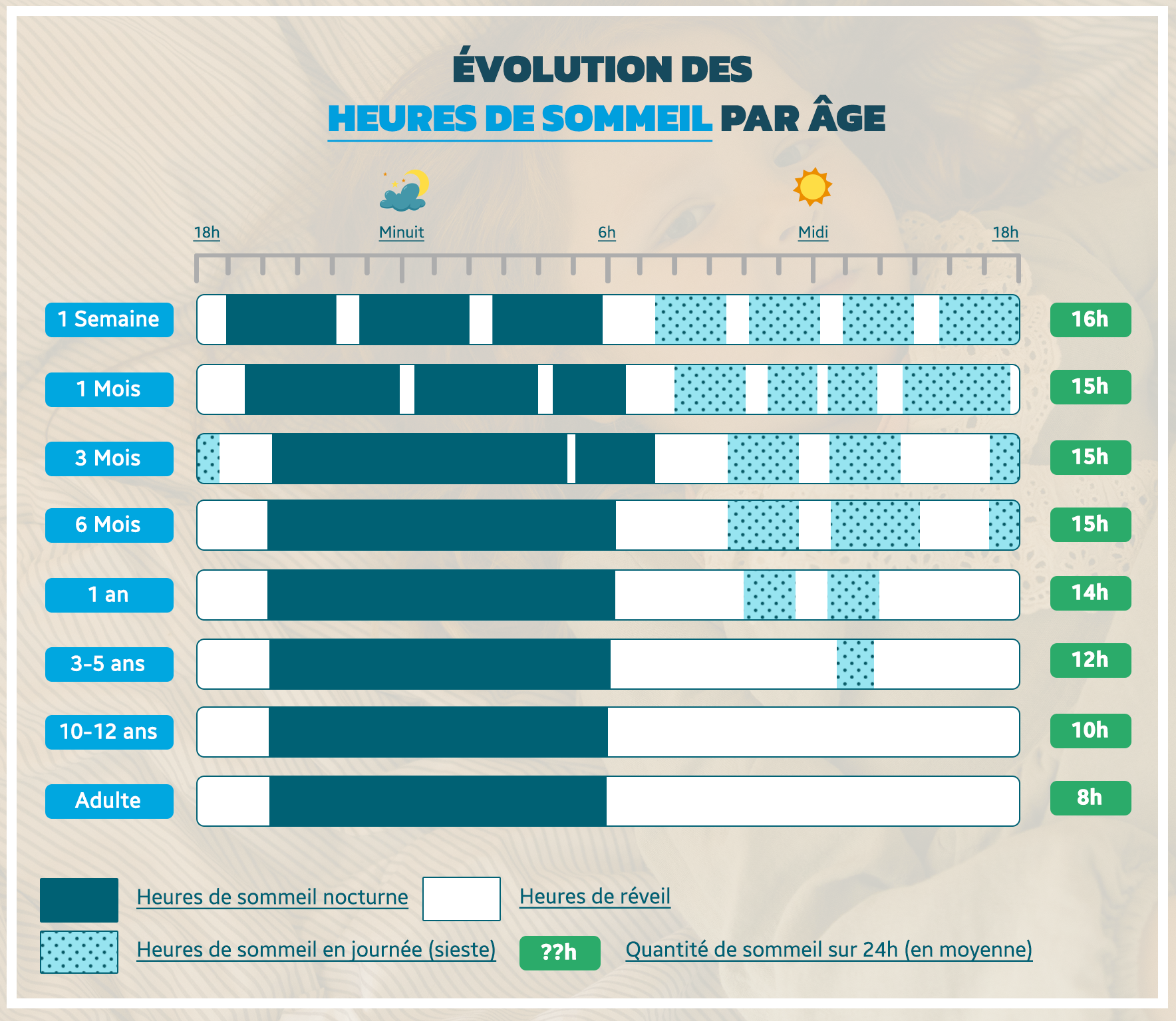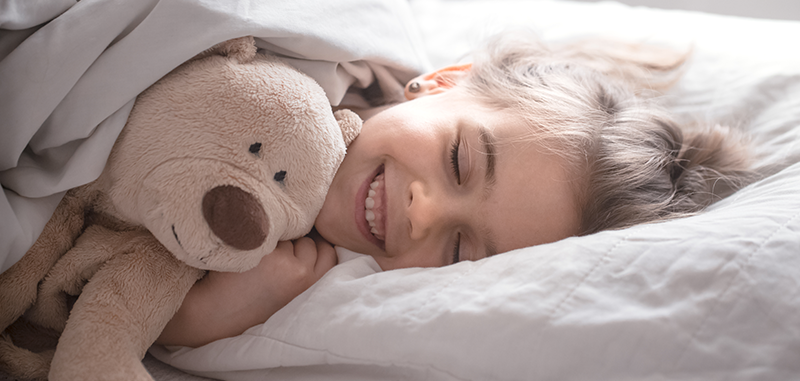The best time to put your child to bed!

Your child's sleep is essential—for their health, development, and your peace of mind. Find out how many hours of sleep your child needs based on their age, and how to improve the quality of their sleep for the whole family.
As a parent, you know how important restful nights are—not just for your own well-being, but for your child’s healthy development. Sleep plays a crucial role: it’s when the body grows, the brain processes new information, and emotions are balanced.
A well-rested child is a happier child—more focused, more resilient, and more ready to discover the world around them.
But how much sleep do kids need exactly? Is it normal if your child still wakes up at night? When should naps start to decrease? These are all valid questions—and we’re here to answer them clearly and confidently in this guide.
So let’s dive in: how many hours of sleep does your child really need at each stage of growth?
Recommended Sleep Chart by Age: How Much Sleep Do Kids Need?
| 🧒 Age | ⏰ Total Sleep in 24 Hours | ⏱️ Awake Time | 😴 Naps | 🌙 Nighttime Sleep |
|---|---|---|---|---|
| 0–1 month | 16–20 hours | 30 min to 1 hour | Frequent | 8–10h Interrupted by feedings |
| 2–3 months | 15–18 hours | 1h to 1h30 | 3 to 6 naps | 9–12h Interrupted by feedings |
| 4–7 months | 14–18 hours | 1h30 to 2h | 3 to 4 naps | 10–13h 0 to 3 feedings during the night |
| 8–14 months | 13–17 hours | 1h45 to 2h30 | 2 naps | 10–13h Uninterrupted sleep |
| 15–23 months | 13–16 hours | 2h to 4h | 1 to 2 naps | 10–13h Uninterrupted sleep |
| 2–3 years | 12–16 hours | 4h to 5h | 1 nap | 11–13h Uninterrupted sleep |
| 3–5 years | 11–14 hours | 5h to 6h | 1 nap | 11–13h Uninterrupted sleep |
| 6–12 years | 9–12 hours | 8h to 10h | No naps | 9–12h Uninterrupted sleep |
| 13–18 years | 8–10 hours | 10h to 14h | No naps | 8–10h Uninterrupted sleep |
It’s important to understand that sleep needs in children vary greatly depending on their age and stage of development.
In the first few months, newborns sleep between 16 and 20 hours a day, although their sleep is often interrupted by feedings. Around 6 months, babies start sleeping longer at night, with naps spaced throughout the day.
Between ages 1 and 3, children typically need 12 to 16 hours of total sleep in a 24-hour period, including naps. After age 3, they usually sleep 11 to 13 hours, with a nap often continuing until around age 5. From 6 years on, daytime naps fade away, but a full 9 to 12 hours of nighttime sleep is still essential. Teenagers, too, need 8 to 10 hours of nightly rest to support both physical and mental development.
Meeting these sleep hour recommendations is key to your child’s well-being, learning, and overall health.
If you’d like to easily calculate how much sleep your child is getting—from newborn to 18 years—you can use our online sleep calculator right here:

How a Child’s Sleep Patterns Evolve Over Time
👉 0 to 6 Months: Learning the Day-Night Rhythm
In the first few months, your baby’s sleep patterns change rapidly. From 0 to 6 months, babies sleep a lot—between 16 and 20 hours a day—but this sleep is broken into short periods, since newborns don’t yet distinguish between day and night. This is known as an ultradian rhythm, where sleep cycles repeat throughout the day without any clear pattern.
Around 2 to 3 months, you’ll likely notice some promising signs: your baby begins to understand that nighttime is meant for longer sleep (yes, your little one is already that clever!).
Gradually, your baby’s nervous system and internal clock mature, helping them differentiate between night and day. This marks the start of longer nighttime sleep stretches and a more organized sleep schedule.
During this phase, it’s important to support your baby’s sleep development by creating the right environment. Natural light plays a key role in building this distinction: during the day, keep the space bright—even during naps—and let household activity continue. As evening approaches, slow things down. Lower the lights and sounds, and begin a soothing bedtime routine to signal that sleep is coming soon.
Babies are very sensitive to their surroundings. They need consistency to feel safe and learn when it’s time to rest. Providing familiar cues and routines helps them slowly understand when nighttime sleep begins.
Around 4 months, some babies may start sleeping 6 to 7 hours in a row—a milestone often called “sleeping through the night.” This is a big step, but every child develops at their own pace. What matters most is maintaining a calm, consistent bedtime routine and sleep-friendly environment, which are crucial for brain development and overall well-being.
To learn more, check out our complete guide to newborn sleep during what’s often called the “fourth trimester”: 1-Month Baby Sleep: Patterns, Tips & Practical Advice
👉 6 Months to 4 Years: Gradually Reducing Daytime Sleep
From around 6 months of age, your child’s sleep schedule becomes more structured. While they may take 3 to 4 naps a day at 6 months, this typically drops to 2 naps by 12 months, and then to a single nap around 18 months.
Even with fewer naps, the total amount of sleep your child needs remains high—about 15 hours a day at 6 months, gradually decreasing to 13 or 14 hours by age 4. This is a key phase where daytime sleep reduces, while nighttime sleep becomes more consolidated and consistent.
However, this period can also bring bedtime challenges. As children become more aware of themselves and their surroundings, they may begin to resist sleep due to separation anxiety. They realize that sleep means being apart from their parents, which can trigger protests or bedtime stalling. It often becomes a testing ground for limits, where children explore how their parents respond. Add to this the appearance of nightmares or other sleep disruptions, and it’s not uncommon for kids to feel some anxiety about “letting go” and falling asleep.
Night wakings—especially during the second half of the night—are also very common at this age. According to some studies, around 40% of 18-month-olds regularly wake up after midnight. These longer or repeated wake-ups are a normal part of the maturing sleep cycle, which becomes more complex as children grow.
That said, if your child needs your help every time to fall back asleep, it can become a problem. It’s important to support their growing independence by helping them learn to settle back to sleep on their own. This includes creating a soothing sleep environment and establishing consistent bedtime cues, so they learn that nighttime is a calm and secure time for rest.
👉 Ages 4 to 12: Gradual Reduction in Total Sleep Time
From age 4 onward, children begin to show a noticeable decrease in the total amount of sleep they need, with their patterns gradually resembling those of adults. It’s often a time when kids seem unstoppable—bursting with energy all day long and acting like they never get tired. And yet… when bedtime comes, they often fall asleep in seconds, diving into a deep, restful slumber.
The biggest change during this stage is the gradual disappearance of daytime sleep. While naps may still be common around age 4, they become less frequent as the child grows. Eventually, a full night of sleep is all they need to recharge. That said, a quiet rest period between 12:00 and 2:00 PM—even without a full nap—can still be helpful for many children. This downtime helps them reset and stay focused for the rest of the day.
This shift toward nighttime-only sleep also affects the quality of sleep. Deep sleep, which occurs mainly in the early part of the night, becomes increasingly important. It’s during this time that children recover from physical activity and mental stimulation. It’s also the stage where you might notice new sleep issues, such as occasional wake-ups or trouble falling asleep. These disruptions can stem from an overstimulating environment or inconsistent bedtime habits.
That’s why it’s so important at this age to establish a consistent bedtime routine. A calm environment, simple rituals like reading a story, and regular sleep schedules can make a big difference. A predictable bedtime routine helps your child recognize that nighttime is for rest—leading to better sleep quality and easier bedtimes.
- Better mood: Quality sleep helps regulate emotions.
- Improved focus: Kids are more attentive and engaged.
- Healthy development: Honoring their natural sleep rhythms supports growth.
To understand why respecting the right bedtime is so important, check out our full article here: What Time Should Kids Go to Bed? The Ideal Sleep Schedule by Age

The Consequences of Sleep Deprivation in Children
Sleep—often overlooked in our busy daily routines—is actually crucial for a child’s healthy development. Research is clear: not getting enough sleep can deeply affect a child’s behavior, cognitive abilities, and even physical health.
For example, a 2007 study published in the journal Sleep found that children under age 3 who slept fewer than 9 hours a night had a higher risk of developing impulsive behavior by age 6, compared to those who got adequate sleep. Among infants under 18 months, sleeping less than 10 hours per day—especially with frequent night wakings (more than 3 times per night)—was also linked to increased behavioral issues by age 5.
But the effects of sleep deprivation go even further. In addition to behavioral concerns, poor sleep can directly impact academic performance. Even losing just one hour of sleep per night can significantly reduce a school-aged child’s ability to concentrate and retain new information. On the flip side, children who sleep well and meet their sleep needs often show stronger performance at school—clear proof that sleep is a powerful ally for learning.
Sleep also plays a key role in physical health. Several studies have identified a link between sleep reduction and weight problems. Short nights can disrupt the hormones that regulate hunger—like ghrelin and leptin—increasing the risk of being overweight or obese.
Lack of sleep doesn’t only affect the child—it can weigh heavily on the whole family, increasing stress and anxiety levels in parents. It’s a tiring and emotionally draining situation for everyone. That’s why the World Health Organization includes sleep in its official guidelines for supporting healthy childhood growth.
Sleep is far from a secondary concern!
So, keeping a close eye on your child’s sleep is not just about supporting their long-term well-being—it also helps maintain harmony within the family.
But what if, despite your best efforts, your child still has trouble falling asleep or wakes up multiple times during the night? Don’t worry—there are solutions!
We’ve created a full blog article packed with practical tips to help children get back to peaceful, restful sleep. Whether it’s adjusting the bedtime routine or creating a calming sleep environment, you’ll find helpful strategies to guide your child toward better, more restorative nights.
To learn more, check out the article right here: Sleep Problems in Children: How to Restore Calm Nights
Is My Child Getting Enough Sleep?
We often track our baby’s weight curve closely, celebrate every tiny milestone… so why not do the same with their sleep? After all, good sleep is just as essential as nutrition for healthy growth! Keeping a simple sleep log can help you better understand your child’s needs—in a light, no-pressure way.
You don’t have to do it forever! Tracking for just two or three weeks is often enough to spot any patterns. It can even become a fun family project: noting bedtime, wake-ups, and naps, observing habits, and seeing whether small changes (like moving bedtime earlier or shortening a nap) make a difference. You might be surprised by what you find!
Keeping track of your child’s sleep hours isn’t just about checking if they’re getting enough rest—it’s also a great way to catch small issues that might otherwise go unnoticed. If you spot frequent wake-ups, trouble falling asleep, or very short naps, you'll have a solid base to bring up with your pediatrician.
And it’s also a great opportunity to introduce a bit of sleep education for your child. Talk to them about how sleep helps them grow, stay focused at school, and feel their best every day. Getting your child involved in the process can help them understand the value of sleep and build healthy habits from an early age.
And if everything’s going smoothly? Then you’ll simply have the peace of mind that your little one is sleeping like a champ. So why not give it a try and see what you discover about their sleep?
👉 For 2 to 4 weeks, write down bedtimes, nap durations, wake-up times, and record your nightly observations (Was falling asleep easy or difficult? Any night terrors or nightmares? Was your child cranky or calm during the day? Etc.)
To make it easier, we’ve designed a printable sleep log you can hang on the fridge! It's a fun and interactive way to help your child understand and manage their sleep more independently.
Note: This information can also be reviewed by pediatric sleep specialists during consultations.
If you'd like to learn more about how to use our sleep tracker, check out the full article here: 📆 Children's Sleep Log: A Must-Have Tool for Peaceful Nights
Online Sleep Calculator for Babies & Kids
Discover REMI
THE SMART ALARM CLOCK 😊
REMI and its app bring together everything you need to manage your baby’s sleep!
Its mission? Helping families sleep better — from birth up to age 10.
I bought REMI for my 4-year-old son who didn’t want to sleep alone anymore after his little sister was born. Thanks to the remote wake-up system and bedtime stories I can play from a distance, the issue is completely resolved! I 100% recommend this purchase!





 My Child Won’t Sleep Alone: How to Help Them Gain Independence
My Child Won’t Sleep Alone: How to Help Them Gain Independence
 Letting Baby Cry It Out: Effective, But At What Cost?
Letting Baby Cry It Out: Effective, But At What Cost?
 White noise for baby : a scientific research !
White noise for baby : a scientific research !
 What are the positive effects of napping on memory?
What are the positive effects of napping on memory?
 What Time Should Your Child Go to Bed? The Ideal Bedtime by Age!
What Time Should Your Child Go to Bed? The Ideal Bedtime by Age!